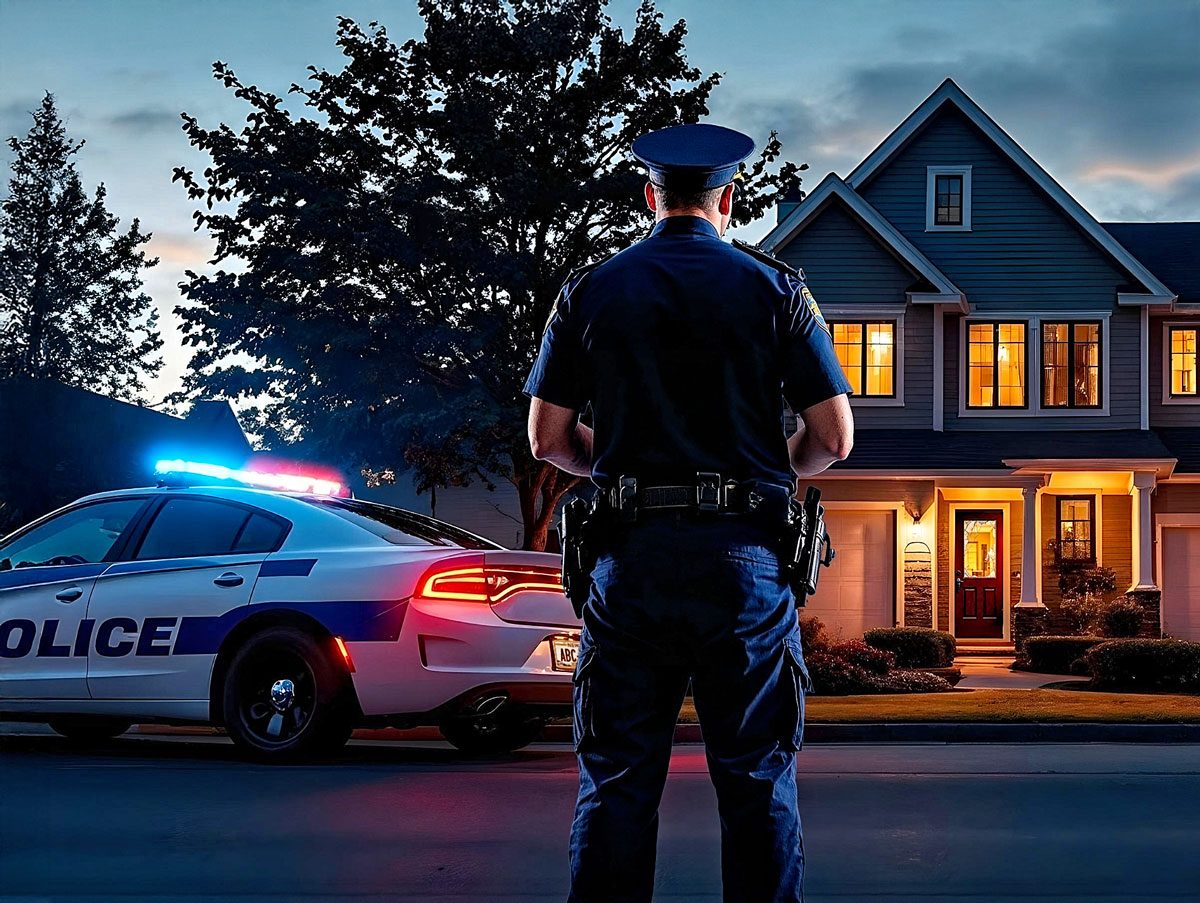Your home is your castle—until some stranger insists it’s theirs

“The Squatter in My House”: Real-Life Tales About Very Unwelcome Guests


When Genesis Gonzales got home last June from a long visit with her family, seven months pregnant and with a toddler in tow, all she wanted to do was relax. The stranger on her couch had other ideas.
“All of a sudden, I get a text: ‘There’s someone in our home!’ ” says her husband Jaime Gonzales, who was coming home separately to the family’s Salt Lake City apartment. “It was a woman on our couch, with a teddy bear, watching TV. She said, ‘This is MY house! Get out of here and take that baby with you!’ ”
Genesis was stunned. The Gonzales family lives on the top floor of a large complex of about 700 units—not exactly an easy target for break-ins. But as she approached the apartment door, she realized that something was amiss. The lock was missing. A dishrag was stuffed in the hole. She stepped inside and saw the apartment in shambles. As soon as the woman started yelling from the couch—wearing one of Genesis’s shirts, no less—it became clear: They’d been squatted.
She fled down the hallway and called the police. But what would come next? Would the stranger be arrested? Would Genesis be arrested? Would she, her husband and the baby have a home to return to?
Keep reading to find out what happened, as well as get expert advice from housing pros on how to handle a squatter if you ever find yourself in this situation.
Get Reader’s Digest’s Read Up newsletter for more true stories, fun facts, humor, cleaning, travel and tech all week long.
Squatters or tenants?
The term squatter covers a lot of territory. Sometimes it’s an invited guest who won’t leave. Sometimes it’s an Airbnb customer who stops paying. Sometimes it’s a desperate character hiding in a crawl space or garage. Sometimes it’s a well-meaning neighbor trying to make an abandoned space useful.
However you define it, press reports suggest that squatting has proliferated in the last few years, becoming a particular concern in sprawling suburbs where vacant homes are common and can be easily located through online real estate listings. A 2024 member survey by the National Rental Home Council, an advocacy group representing landlords and property owners, says the highest number of recent squatting reports have come from the suburbs of Atlanta, Orlando and Dallas. The Pacific Legal Foundation, which advocates for property rights, shows the number of squatting cases brought to court in Georgia alone jumped from just three in 2017 to 198 in 2023.
“Sometimes, the very first day that a property is listed, the squatters move in,” says David Metzger, a real estate attorney in the Atlanta area who has handled dozens of squatting incidents.
When he started his practice in 2011, squatting wasn’t common. “I had done three or four squatting cases until 2023,” he says. “Then all of a sudden in 2023 we saw an explosion of cases.” Metzger thinks that spike has been driven by a mix of factors, including rising housing costs, court backlogs related to COVID-19, and relatively low criminal penalties for trespass. Many would-be squatters have learned how to work the system, claiming to be a legal tenant and fending off police and court officials with false paperwork. “They almost always have a fake lease—you can download them from the internet,” says Metzger. “The police come, and they show the lease to the officer.” And at least for a while, it can be enough to keep them from being booted out.
Trespassing is a crime, and one truth about squatters is that most get removed quickly. But another truth is that under the right conditions, that stranger on the couch might stay for weeks, months or even years. In Houston, a real estate broker found a supposedly vacant home occupied by an entire family, including a fourth grade teacher. The family used a fake lease and other claims to fight eviction, and they didn’t leave for a year.

In Louisville, Kentucky, Daniel Toma allowed two friends to sleep in his garage while they fixed their car. The couple soon changed the garage’s locks and made themselves right at home by installing cable TV service in their names. The legal specifics defining “tenant” vary from state to state. But generally, anyone who is invited to stay in a given property can become legally recognized as a tenant within a month or less. And tenants have rights to due process before being evicted. This creates a challenge for police officers: When they’re called to a home to settle a dispute between residents, it’s not always easy to confirm who has what rights.
For example, there’s usually no fast way to confirm who signed a lease with whom; police can’t dial in to some centralized database of landlords and renters. Sometimes police can quickly arrest and remove alleged squatters, usually because there’s evidence of property crime. But whenever the situation is at all unclear, police refer the matter to housing court.
These legal protections keep a tenant from being summarily kicked into the street on a landlord’s say-so. But they can be exploited by bad actors, leading to seemingly absurd situations like the one in New York City last April, in which a woman named Adele Andaloro changed the locks on her home in Queens to get a squatter out. The squatter told police he was a tenant with a lease, so Andoloro found herself arrested and charged with unlawful eviction. It took her a month to get the charges dropped and the squatter arrested.
“In the strict legal sense, squatters have no rights, whereas a tenant has all kinds of rights,” says Metzger.
From settlers to activists
Walking into your home and finding it occupied by a stranger is certainly cause for alarm. But it’s important to note that not every squatter is malicious. Many see themselves as working for the common good.
Mark Covington thinks of himself as a community activist. He leads the Georgia Street Community Collective, which runs a cluster of community gardens and youth programs in Detroit. The nonprofit owns over a dozen formerly abandoned properties, but it got started on land that Covington had no legal right to use. “I knew the city owned it,” Covington says. “But I wasn’t thinking about ownership. I wanted to make the neighborhood better. I wanted to grow vegetables.”

He’s part of an American tradition that dates back to the nation’s earliest days. The word squatter was coined in the late 1700s, when it was used by a Founding Father to derisively describe the landless settlers staking out claims on the frontier. These homesteaders created legal headaches for colonial landowners and often sparked bloody conflicts with Native Americans.
In a letter to future president James Madison, Nathaniel Gorham of Massachusetts wrote that such “squatters on other people’s land” might oppose the Constitution, as “they are afraid of being brought to account.” Among the first Americans to tangle with these sorts of squatters was George Washington, who discovered in 1784 that a feisty group of “willful and obstinate sinners” had built homesteads on his land in western Pennsylvania. He was able to evict them only after a two-year court fight.
Later, during California’s gold rush, local landowners faced a flood of treasure-seeking squatters, whose demands for legal protections culminated in the 1850 Squatters Riot that left four men dead. By the time of the Great Depression, the word was used to describe impoverished workers living in “squatter’s shacks” and shanties. And by the 1960s and ’70s, the term included the artists and activists turning abandoned urban buildings into “squats.” Soon, New York City became a hotbed for activist squatters. And it still is.
“These are people who really care about the neighborhood,” says Bill DiPaola, the director of Manhattan’s Museum of Reclaimed Urban Space. “Ninety-nine percent of the places that were squatted, they’re now productive places that contribute to the community.” So much so that 11 squatted buildings were legalized with the help of the city’s Urban Homesteading Assistance Board, created in 1973. Also remaining on the Lower East Side are about 40 community gardens built on what had been vacant lots.
“Community gardens are squats too,” DiPaola says. “Most of the community gardens around here were city-owned land, and people just moved in.” That describes what Detroit’s Mark Covington did. He squatted his first garden plot in 2007, when he was living with his mother in their family home. The neighborhood was full of abandoned, trash-strewn lots.
“It was a mess. I decided I was going to start cleaning it up. I figured, nobody’s going to dump on food,” Covington says. It worked. Covington and his neighbors gardened on the city’s lot for eight years before successfully buying it. “I didn’t know how to start a nonprofit. I didn’t know how to do anything!” Covington says. But he knew this much: “Land is power. We’ve got to take better care of it.
“You can’t make me leave”
But most squatters aren’t in it to improve their communities; they are in it for themselves. That’s what a family in Colorado Springs, Colorado, discovered when a retiree named William Towns invited a homeless woman to stay in his home for a few days. When the days turned into weeks, and Towns and his guest started having conflicts, his family stepped in. “We said, ‘It’s been over a month. It’s time to move on,’ ” says Alicia Jordan, one of Towns’s two daughters. “And she says, ‘You can’t make me leave.’ ”
To Jordan’s horror, she found that the woman’s boast was true—at least, at first. The saga began when Jordan’s father, 76 and recently diagnosed with dementia, met a woman in the neighborhood who was sleeping in her car.
“He’s one of those types who lovesto talk to anybody,” Jordan says. “He wanted to hear her story, so he invited her to have some iced tea.” Eventually, Towns invited the woman to stay for a few days while her car was being fixed. He had no idea what he was getting into. “Her boyfriend showed up that afternoon,” Jordan says. “My dad woke up one morning and her 15-year-old son was there with a cat. Then she just stayed.” The situation quickly spiraled out of control. “There were more and more confrontations,” Jordan says. “She really started to take over the house. Yelling at him for not fixing the shower fast enough—like it was her house!”
Other problems emerged too: The woman’s boyfriend wouldn’t stop hanging around, making vague threats about reporting Towns to the police for building code violations like improper wiring. The couple parked two cars, neither of which would run, on the property. Towns grew anxious and stopped taking his medications. But when Jordan called police about the problems her father’s invited guest was creating, she discovered that as far as the law was concerned, the woman was a tenant until proven otherwise. “Every time they’d come to the door, they’d say, ‘She’s your tenant. This is a civil matter; you have to go to the courts,’ ” says Jordan.
Things got so ugly that Towns’s daughters moved their father out of his house and into one of their own. That left the woman, her boyfriend, her son and the cat as the sole occupants of William Towns’s house. They quickly made themselves at home, smoking and partying, welcoming guests and even growing magic mushrooms (which is legal in Colorado) in the living room. For weeks, all the Towns family could do was watch it all on their security cameras. “We’re sitting there watching them live their life, going through our family belongings. It was heart-wrenching,” says Jordan. “The whole time they’re talking to the cameras, flipping us off.”
The family started formal eviction proceedings; the squatters appealed and stayed. The Towns family only ended the stalemate when they sought criminal charges of “elder abuse.” William Towns and his family testified that the squatters had threatened and mistreated him, backed by evidence from their cameras. The judge agreed, and ordered the squatters removed. “I cried at the moment the judge granted that order,” says Jordan. “That afternoon, the sheriff’s department was there. They had to be out in 15 minutes.”
In theory, through what’s known legally as “adverse possession,” it’s possible for squatters to claim ownership of property they occupy. But in practice such a claim is all but impossible to make successfully. To win legal possession by squatting, it generally takes many years of continuous, open and—critically—unchallenged use. Some squatters do attempt elaborate deed fraud schemes in order to literally steal a home. But squatting alone will virtually never lead to actual ownership. What squatters can do is leave behind a lot of headaches.

In Colorado Springs, William Towns was finally able to return to his home after about a month living with one of his daughters. Between lawyers, cleanup and a new security system, the whole affair cost the family about $6,000. A permanent protection order now bans the squatters from being near Towns, his property or his dog, but the whole affair was hard on him, his daughter says. “He couldn’t sleep, he couldn’t function—he was just so worried about his house,” says Jordan. “He thought he might lose it.”
Taking action
Outrageous stories like those of the Towns and Gonzales families helped drive a surge of national news coverage, and in some cases legal action. In several states, including New York, Georgia and Florida, lawmakers have proposed or passed new laws empowering police to more quickly evict alleged squatters.
The new laws do have some potential drawbacks, advocates say, by putting police in the position of having to settle competing claims on the spot. “The risk is that somebody with a legitimate right to be in a property gets summarily removed without a right to defend themselves,” says Eric Dunn, director of litigation for the National Housing Law Project, a nonprofit advocacy group. And sometimes, says Claire Herbert, a sociologist at the University of Oregon, “squatter” is just a convenient accusation. “In Detroit, they set up a hotline so people could report squatters,” she says. “All that happened was that people were calling up to complain about their neighbors.”
Nevertheless, squatting does occur, and experts say the best way to protect your property from being squatted is to keep a very close eye on it. Unoccupied properties appear to be the most at risk for break-ins: that includes homes up for sale or rent, homes being renovated, or homes left vacant when an owner moves or passes away.
For occupied homes, monitoring and reporting problems with tenants is essential. For example, if an invited guest or Airbnb tenant starts creating issues, landlords should document them right away. “We learned from this process that you have to report everything,” says Jordan. “The Colorado Springs police know our address now.”
When police are called to a home and can determine that a crime was committed, like breaking and entering, they can act quickly. That’s how it worked out for the Gonzales family in Salt Lake City. As soon as Genesis Gonzales discovered the woman on the couch, she called the police. When her husband got to the building, the squatter was already in handcuffs, sitting in the back of a squad car. The couple was told that the woman had admitted to talking her way through the building’s front gate and then prowling the halls, watching to see which apartments were empty, before breaking into the Gonzaleses’ home. She had stayed for about a week,the Gonzales family learned. During that time, some of their property disappeared, presumably stolen: baby clothes, kitchenware and a valuable engagement ring. The squatter had stocked the fridge with TV dinners, apparently hoping for a lengthy stay.
Instead, she left the Gonzales family with about $13,000 in losses. She also left a week’s worth of trash, piled up everywhere. Building management replaced the locks and the apartment’s front door. Friends helped Jaime scrub the apartment. And then they added some security, just in case. “My neighbors got a camera. We got a camera,” says Jaime Gonzales. “If it happens once, it could happen again.”
About the experts
|
Why trust us
At Reader’s Digest, we’re committed to producing high-quality content by writers with expertise and experience in their field in consultation with relevant, qualified experts. We rely on reputable primary sources, including government and professional organizations and academic institutions as well as our writers’ personal experiences where appropriate. We verify all facts and data, back them with credible sourcing and revisit them over time to ensure they remain accurate and up to date. Read more about our team, our contributors and our editorial policies.
Sources:
- David Metzger, Atlanta-based real estate attorney
- Mark Covington, community activist, leader of the Georgia Street Community Collective
- Bill DiPaola, director of Manhattan’s Museum of Reclaimed Urban Space
- Eric Dunn, director of litigation for the National Housing Law Project
- Claire Herbert, sociologist at the University of Oregon
- Eppraisal: “The Impact of Squatting on Real Estate Investors: Risks, Challenges, and Solutions”
- National Rental Home Council
- Newsweek: “Squatting Map Shows Cities with Highest Number of Homes Taken Over”
- Nolo: “Criminal Trespassing Law”
- ABC13 News: “‘Finally they’re out’: Squatters living in SW Houston home move out after living there for 6 months”
- Newsweek: “Judge Orders Homeowner to Leave House After Fight with ‘Squatters'”
- Internet Archive: “Full text of ‘The contest over the ratification of the Federal Constitution in the State of Massachusetts'”
- Explore PA History: “George Washington, Covenanter squatters Historical Marker”
- The Clio: “Sacramento Squatters’ Riots of 1850”


